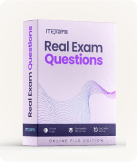VMware 2V0-13.25 - VMware Cloud Foundation 9.0 Architect Exam
Page: 2 / 18
Total 89 questions
Question #6 (Topic: Exam A)
As part of the VMware Cloud Foundation (VCF) logical design, the architect documented the following requirement:
The solution must include high security hardening levels to meet military compliance standards.
Which two physical design decisions will meet this security requirement in the workload domain? (Choose two.)
The solution must include high security hardening levels to meet military compliance standards.
Which two physical design decisions will meet this security requirement in the workload domain? (Choose two.)
A. VCF Operations will be configured to renew the SSL certificate for vCenter Server per security policies.
B. The vSAN storage policy will be configured as Secondary Failures to Tolerate = 1.
C. The certificate of the VI workload domain vCenter Server will be issued by RootCA.Military.Domain.com.
D. The advanced setting UserVars.SuppressShellWarning will be configured to 0 across all ESXi hosts in a VI workload domain cluster.
E. NTP will be configured to the internal NTP servers of 192.168.12.1 and 192.168.24.1.
Answer: AC
Question #7 (Topic: Exam A)
An architect is designing a new VMware Cloud Foundation (VCF) solution. During the discovery workshops with the customer, the following information was shared:
The company is structured into multiple business units.
Some business units were formed through the acquisition of other companies.
As the acquisitions were completed recently, these business units use their own Active Directory (AD) instances for authentication.
All business units operate independently of each other, and need their own dedicated development environments.
The customer wants to use VCF Automation to provide its employees with the ability to self-service the provisioning and ongoing management of their resources within defined boundaries.
Which two design decisions should the architect include in the design when documenting the configuration of VCF Automation? (Choose two.)
The company is structured into multiple business units.
Some business units were formed through the acquisition of other companies.
As the acquisitions were completed recently, these business units use their own Active Directory (AD) instances for authentication.
All business units operate independently of each other, and need their own dedicated development environments.
The customer wants to use VCF Automation to provide its employees with the ability to self-service the provisioning and ongoing management of their resources within defined boundaries.
Which two design decisions should the architect include in the design when documenting the configuration of VCF Automation? (Choose two.)
A. A VCF Automation tenant will be created for each business unit.
B. A VCF Automation project will be created for each business unit.
C. All tenants will be configured to use their dedicated AD instance for authentication.
D. All projects will be configured to use their dedicated AD instance for authentication.
E. All tenants will be configured to use the corporate AD instance for authentication.
Answer: AC
Question #8 (Topic: Exam A)
An architect is responsible for designing a VMware Cloud Foundation (VCF)-based private cloud for a customer. The architect noted the following requirements during a design workshop:
Co-locate application workloads with VCF management component workloads within the same vSphere cluster.
Shared storage data is always available and 100% current in the event of a single site outage.
Have two sites available no more than 10 miles apart (10ms latency) connected with high speed network technology to host their virtual infrastructure.
Protect against outages of a single site designated as an availability zone.
Which two storage technologies could meet the stated requirements? (Choose two.)
Co-locate application workloads with VCF management component workloads within the same vSphere cluster.
Shared storage data is always available and 100% current in the event of a single site outage.
Have two sites available no more than 10 miles apart (10ms latency) connected with high speed network technology to host their virtual infrastructure.
Protect against outages of a single site designated as an availability zone.
Which two storage technologies could meet the stated requirements? (Choose two.)
A. NVME over Fibre Channel (FC)
B. VMFS on Fibre Channel (FC)
C. vSphere Virtual Volumes (vVols)
D. NVME over TCP
E. vSAN
Answer: BE
Question #9 (Topic: Exam A)
As part of the VMware Cloud Foundation (VCF) logical design, the architect has determined that the VCF Private Cloud will encompass multiple VCF instances contained within a single VCF Fleet. The architect documented the following requirements when using VCF Operations:
Monitoring downtime must be minimized.
Alerting downtime must be minimized.
Which design decision supports these requirements?
Monitoring downtime must be minimized.
Alerting downtime must be minimized.
Which design decision supports these requirements?
A. Deploy two VCF Operations instances and configure the Aggregator Management Pack.
B. Deploy a single VCF Operations instance across a multi-VCF instance fleet.
C. Deploy VCF Operations using the High Availability model with Collector nodes at remote sites.
D. Deploy VCF Operations using the Simple model with Collector nodes at remote sites.
Answer: C
Question #10 (Topic: Exam A)
As part of the initial design workshop, one of the customer stakeholders has stated the following:
All Virtual Machines must be encrypted.
How would the architect classify this statement?
All Virtual Machines must be encrypted.
How would the architect classify this statement?
A. An Assumption
B. A Requirement
C. A risk
D. A Constraint
Answer: B
